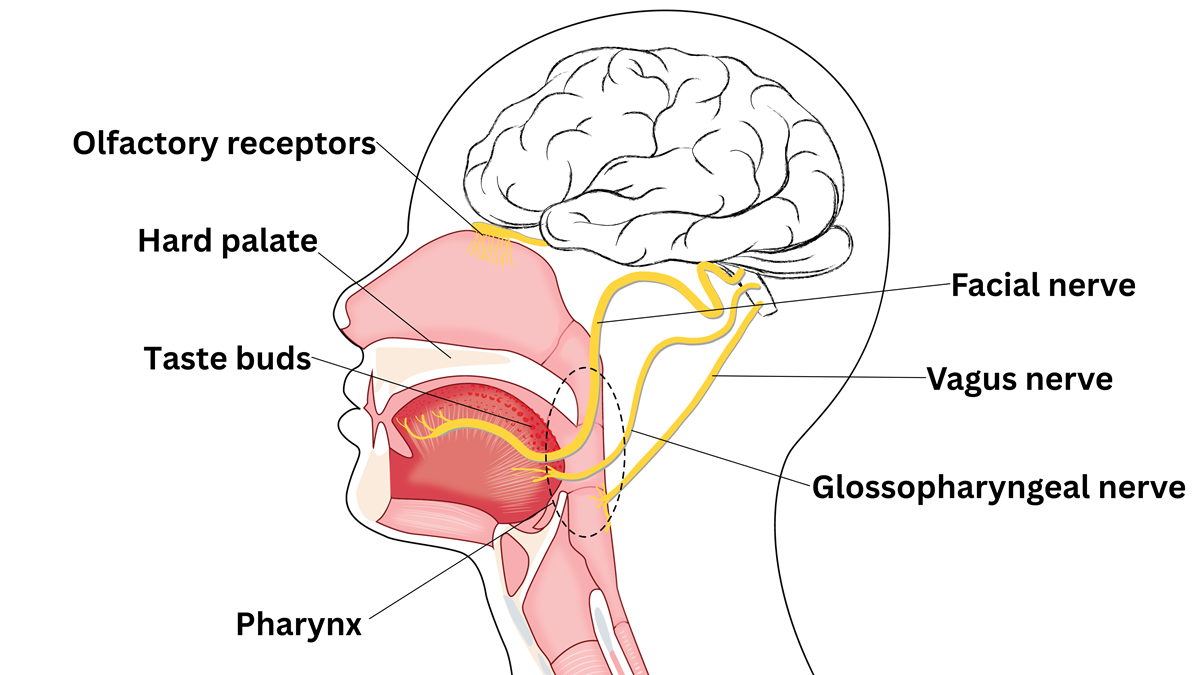How we taste
How we taste
The sensation of taste is a complex one, with many components, several of which can be impacted by salivary gland cancer treatments.
- When food enters the mouth, we chew it to break it down. This releases molecules which activate food receptor cells within taste buds on the tongue.
- The molecules the food releases also travel up behind our hard palette and through the back of the nasal cavity, activating our olfactory receptors.
- The receptor cells in the mouth and nose then send signals to the brain via a series of nerves, which gives us the sensation of taste and complex aromas. These nerves include the Facial nerve, which carries signals from the front of the tongue, the Glossopharyngeal nerve which transmits information from the back of the tongue, and the Vagus nerve, which carries some taste information from the back part of the mouth, including the upper third of the oesophagus.
- The taste buds are found in tiny bumps called papillae. We have between 2,000 and 10,000 taste buds which are found mainly on the tongue, but also on the hard palette and pharynx. They can regenerate every 1-3 weeks, but can only detect 5 key flavours; sweet, salty, sour, bitter and umami.
- It’s therefore estimated that around 80% of our sense of taste actually comes from retronasal olfaction – which means effectively ‘smelling from the back of the mouth’.
Treatment for salivary gland cancers can affect sense of taste in 4 key ways:
- Saliva plays a crucial role in taste, acting as a solvent to dissolve food molecules in the mouth and allowing them to reach and interact with taste receptor cells on the tongue. It also helps to protect these receptors, by stopping them from drying out, or being damaged by bacteria. Enzymes in the saliva also help break down some foods such as starch into simpler sugars, which we can then experience as sweetness. Salivary gland cancer patients often produce less saliva, due to the removal of salivary glands during surgery and damage to the glands during radiotherapy.
- Radiation therapy can directly damage taste buds, which are responsible for detecting taste sensation.
- Radiotherapy can damage the nerves that carry the signals for taste sensation to the brain.
- Radiation can cause inflammation and sores in the mouth and throat, which can make eating difficult and further alter taste perception.
During radiotherapy treatment, some patients report a reduction in or loss of taste, so that food tastes bland, or of nothing at all. Others find that food tastes unpleasant – and seems metallic, bitter or sour. A sense of taste often gradually returns in the weeks and months after the end of radiotherapy, but some people are left with a longer-term reduction in their sense of taste.
Lack of flavour in food can result in loss of appetite, and weight loss. Tips to help with taste changes include:
- Add flavour to food (e.g. lemon juice, herbs, spices)
- Sip liquids frequently to keep the mouth moist
- Use sugarless gum to stimulate saliva production
- Use lip balm to keep lips moisturised
You can get more information and support from Smell Taste, the food and taste loss charity here Home - SmellTaste. They hold regular support group meetings and are hosting a conference in Nottingham on Sat 8th November 2025.
Last Updated September 2025

 Image credit: Hammad K
Image credit: Hammad K